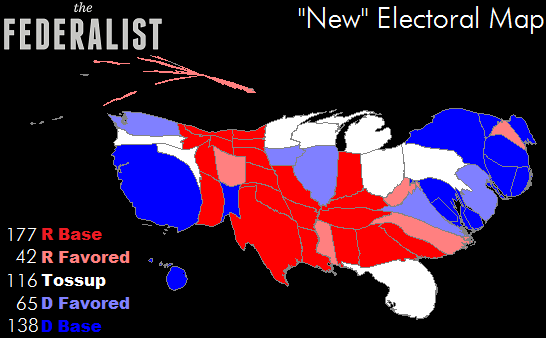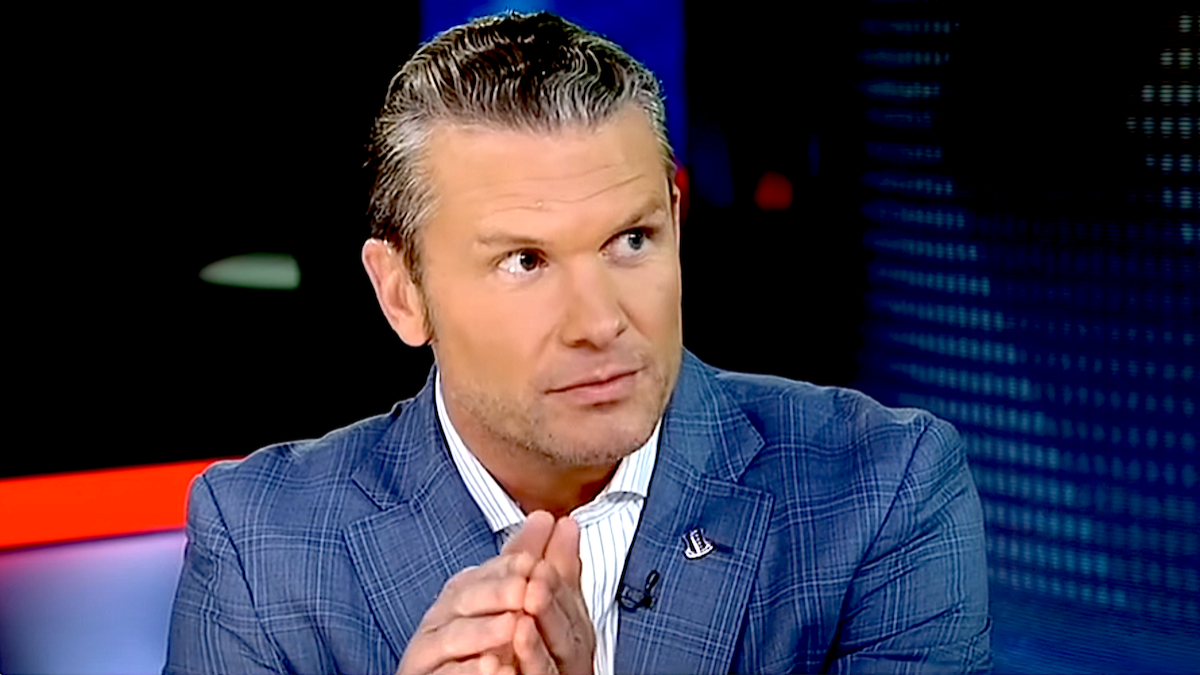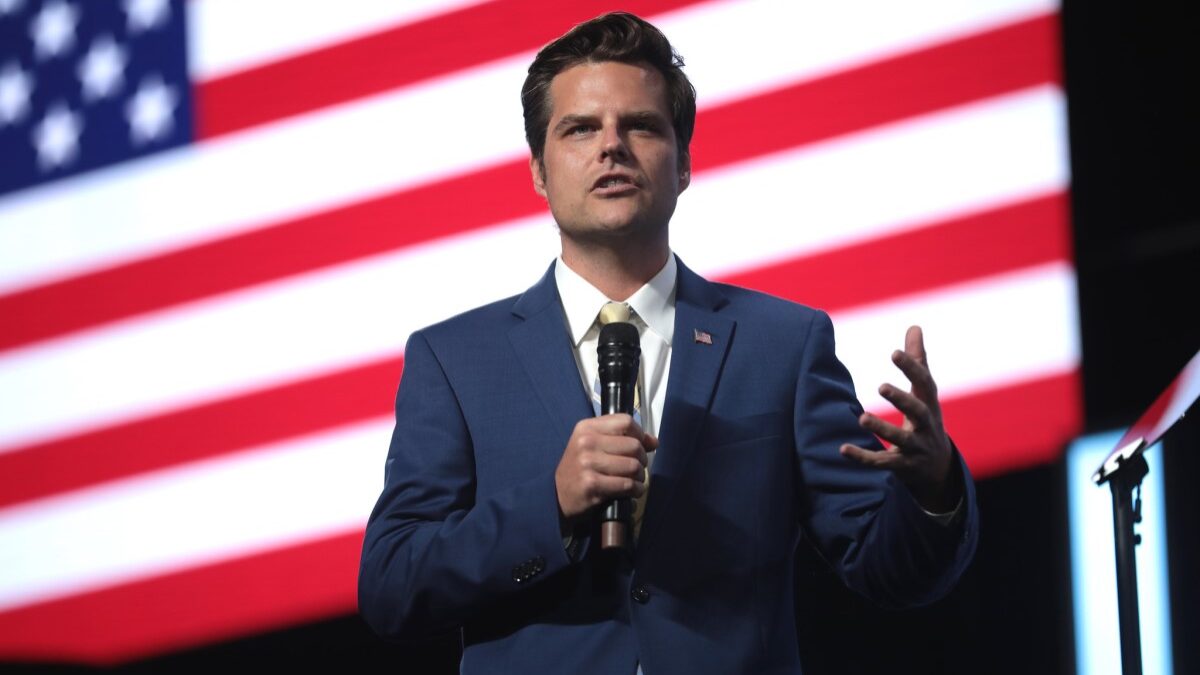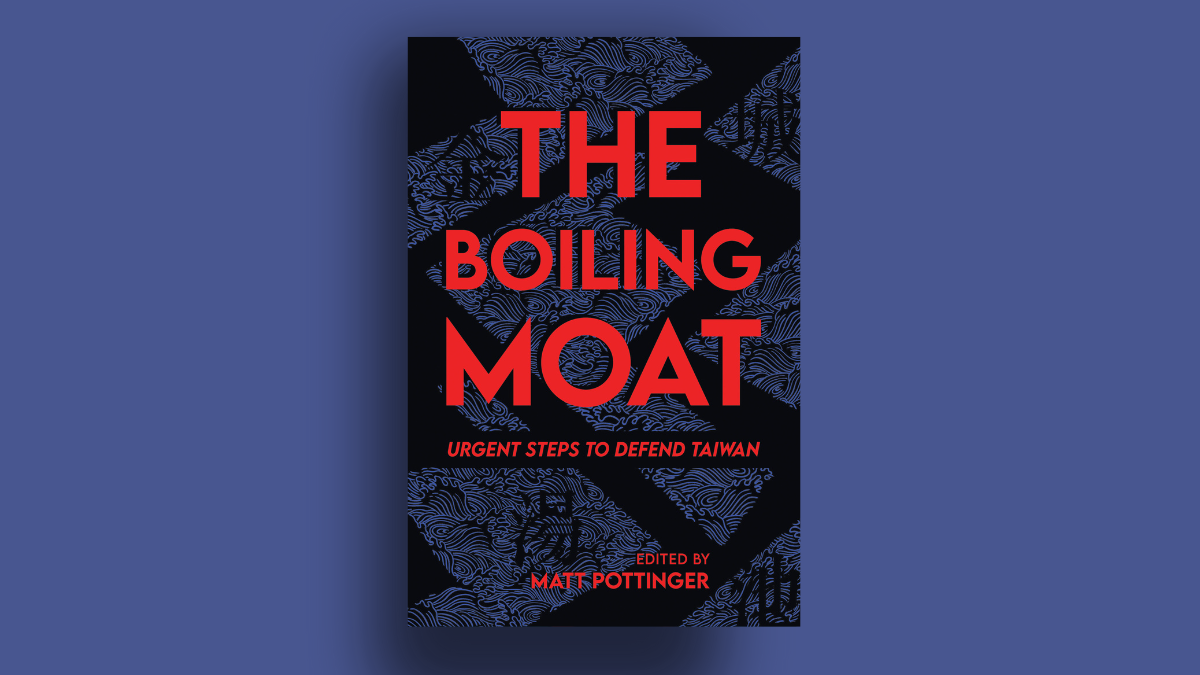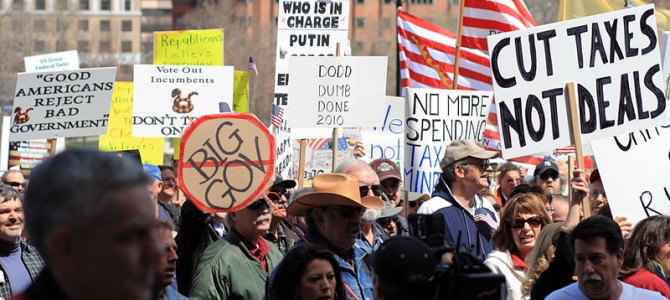
So, I had this crazy thought the other day. What if the Republican Party fully adopted an individual-oriented, crony capitalist- and corporate welfare-fighting, libertarian-populist platform? I know what you’re already saying. Such a shift, after years of corporate sponsorship stretching back to the 1896 election, is very rare in American politics. Rare, as in, it hasn’t happened. But let’s roll with it. Which particular blocs would be more intrigued, which would be turned off, and where, nationally, could the party expect to gain and lose with such a platform?
First, let me try to very loosely define what exactly is being advocated here: a “libertarian-populist” platform would focus on a “fair shot” for all Americans by demanding a market freed of BizGov meddling. It would target corporatism and corporate welfare, the fiscal irresponsibility that results from this, and openly reject the decades-old K Street influence on party positions and congressional votes. The goal is to expand the party’s tent by actively stating and pursuing achievable changes within the U.S. government that appeal to the screwed-over, the suspicious, the cynical, and the rest of the clear-headed realists out there who have seen party differences narrow, the government-corporate complex expand, and have felt their voice and vote increasingly ignored.
Why abandon K-Street, and acknowledge, then reject, the Big Business perception of the GOP? They’ve had the Republican Party’s back for some time, right? In the past, the largest companies favored one party over the other because they understood a pro-capitalist, low-regulation government benefits them.
However, in recent years, especially since the 2007-2008 recession, many have turned to viewing government as a revenue source, a competition crusher, an error-eraser, and a partner in padding their bottom line. Their interest in cheap labor, bailouts, and selectively-favorable legislation has led to a flood of dollars into the Democrat Party, or into political action committees (PACs) that attempt to move Republican congressional votes away from their bases’ expectations, like the U.S. Chamber of Commerce’s push for amnesty. Meanwhile, a mix of bad deals and worse legislation left taxpayers and shareholders on the hook for trillions, millions lost their homes and jobs, and the senators and corporate heads responsible are laughing all the way to the bailed-out bank.
Consider Eric Cantor’s Defeat
Campaigning against this has already worked in one race: the primary in Virginia’s seventh congressional district, where David Brat shocked the world and sent House Majority Leader Eric Cantor into early retirement, featured just such a line of attack, attracting notice from pundits across the spectrum. All politics is local, but more so, all politics features a boogeyman. The boogeyman may change from campaign to campaign, but for decades the Big Business baddie has been a staple of the Left. With the interests of this boogeyman now clashing with those of the conservative base and the potentially Republican but more libertarian or government-skeptical swing voters, it is a line of attack worthy of pursuing to assuage the base, win over an increasingly alienated middle, and, perhaps best of all, is tougher for Democrats to effectively rebut.
Traditional party arguments and partisan positions begin to break down or outright reverse as populist anger rises, as we are starting to see in the Export-Import Bank drama in Washington DC. Where could this new GOP expect to gain and shrink in their share across the electorate?
Let me make it clear that “Big Business” in and of itself is not the problem. I guzzle down Starbucks espresso with my Jack-in-the-Box Munchie Meal, tweet from an iPhone, and poorly obey local traffic laws in my Toyota. We need to encourage economic growth through a free market, and the result of that may be companies that grow quite large. All of that is okay, so long as they don’t become co-opted by government or manipulate our elected officials to game the system. It is collusion with the government through corporate welfare and bailouts, the writing and rewriting of legislation to punish and eliminate competition, and regulatory capture that needs to be loudly stopped. When bureaucrats and boardrooms “come together,” things get nasty.
Consider the Political Typography
That out of the way, Pew Research did us all a great favor with their latest political typography release. After exhaustively interviewing and analyzing thousands of voters’ responses to a wide range of questions, they have divided America into eight groups. From their June release:
Steadfast Conservatives are staunch critics of government and the social safety net and are very socially conservative. Business Conservatives share Steadfast Conservatives’ preference for limited government, but differ in their support for Wall Street and business, as well as immigration reform. And Business Conservatives are far more moderate on social issues than are Steadfast Conservatives.
At the other end of the spectrum, Solid Liberals express liberal attitudes across almost every realm–government, the economy and business and foreign policy, as well as on race, homosexuality and abortion – and are reliable and loyal Democratic voters…Young Outsiders lean Republican but do not have a strong allegiance to the Republican Party; in fact they tend to dislike both political parties. On many issues, from their support for environmental regulation to their liberal views on social issues, they diverge from traditional GOP orthodoxy. Yet in their support for limited government, Young Outsiders are firmly in the Republicans’ camp.
Hard-Pressed Skeptics have been battered by the struggling economy, and their difficult financial circumstances have left them resentful of both government and business. Despite their criticism of government performance, they back more generous government support for the poor and needy. Most Hard-Pressed Skeptics say they voted for Obama in 2012, though fewer than half approve of his job performance today.
The Next Generation Left are young, relatively affluent and very liberal on social issues like same-sex marriage and abortion. But they have reservations about the cost of social programs. And while most of the Next Generation Left support affirmative action, they decisively reject the idea that racial discrimination is the main reason why many blacks are unable to get ahead.
The Faith and Family Left lean Democratic, based on their confidence in government and support for federal programs to address the nation’s problems. But this very religious, racially and ethnically diverse group is uncomfortable with the pace of societal change, including the acceptance of homosexuality and non-traditional family structures.
And finally, an eighth group, the Bystanders, representing 10% of the public, are on the sidelines of the political process. They are not registered to vote and pay very little attention to politics.
I strongly encourage anyone interested in the nuances of the current electorate to read the whole release. There are problems with the survey, as our own David Harsanyi has shown. But it provides a reasonable guide to some of the divisions within the Right, Left, and the all-too-coveted middle.
Going with the various groups outlined by Pew (except for the bystanders, who aren’t engaged), I’ve outlined how much of the overall vote they make, what percentage of them voted for Romney in 2012 (both of these variables are per Pew), what the target percentage with this new GOP should be at a minimum, and the resulting popular vote share:
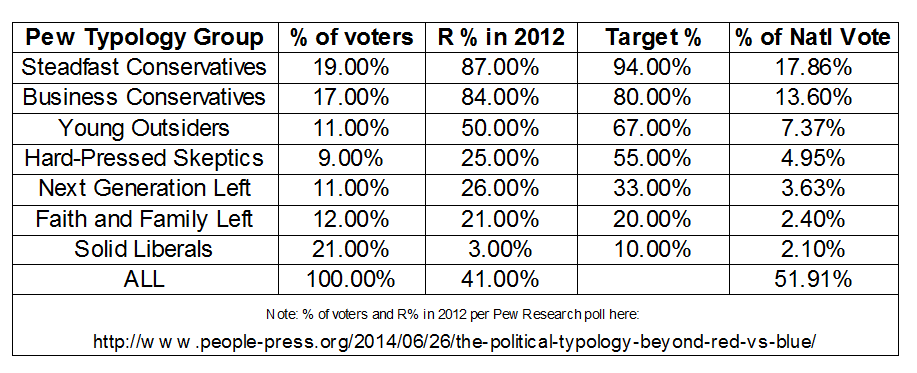
Romney did considerably better than 41 percent in 2012, so increasing fractions among Young Outsiders and Steadfast Conservatives won’t be as challenging, and as I’ll discuss when it comes to the Millenials and GenX voters, it’s not hard to make the rhetoric appealing to reel in the former. Business conservatives may drop slightly if their interest lies in using the government for economic favor, but I suspect that voters with this in mind are a very small portion of that group, although they may make up a much larger portion of the donor class. Most business conservatives, and most businesses, will embrace a system freed of bureaucrat-boardroom meddling.
The more GOP-leaning tossup group, the Young Outsiders, are clearly more interested in conservative attitudes towards government and less so to social issues. This doesn’t mean you abandon social conservatives. That steadfast stool within the party has long complained they would even accept moderated social views in a candidate if they actually got a fiscal conservative who actually governed like a fiscal conservative. Making the desire for a “fair deal” versus favoritism would resonate with many who viewed the bank bailouts as corporate welfare, and these dedicated voters, long complaining about a lack of actual fiscal restraint, will feel they have an ear.
The group that would react the most positively to this shift in focus would be the Hard-Pressed Skeptics. They lost the most in the recession, and would be very receptive to a message that the cronyism that cost them their job and home is a target, not a feature in this new GOP. Populist rhetoric has historically resonated with those on their last nerve, so seeing the Republican share with this group balloon, especially if they see some real action before election season, would go without saying much else.
Meanwhile, solid liberals won’t vote in droves for this new populist-libertarian GOP, but a respectable portion, long weary of the corporatist state, would be expected to cross-over, if just for a short time. Democrats who are more socially conservative may not be drawn to a GOP more focused on purging out the cronies, but they aren’t going to vote substantially less than they already did for Romney. A baseline target of 20 percent among these voters, and 10 percent among solid liberals, is hardly unreasonable but, again, it requires an authentic push towards the libertarian-populist platform. You might be surprised who crosses over if their home party’s candidate is “just another corporatist.”
The Next Generation Left is hardly as monolithic a bloc as the solid liberals, contains a vein of capitalist spirit, and can be courted as well (again, without insulting social conservatives). The aforementioned rejection of corporate collusion could be expected to do well with the NGL bloc, especially if Republicans emphasize their support for the innovation and dynamism of small businesses and the individual entrepreneur. Think of many in this bloc as the hipster set, and really think about the number of offbeat businesses they start, promote, enjoy, implode, and start again. These voters are far more socially liberal than the Young Outsiders, and can be courted by candidates who again emphasize the “fair shot” fiscal attitude while de-emphasizing social conservatism.
All of this doesn’t mean this new GOP should abandon social conservatism, but rather take the libertarian populist message to heart, stage, and campaign. This needs to be the focus. Candidates can still hold and be candid about their attitude on social issues if they can articulate how their position rolls into economic responsibility and the “fair shot.” This shouldn’t be difficult to spell out, and any candidate who can’t make that connection should, frankly, avoid running. Everything in politics isn’t black and white: you don’t need to chase out your base to win over another bloc. Rather, encouraging the socially conservative set to focus and refine their arguments and language could pay dividends for them and rebuild some of the bridges burnt over the last few years. Arguing that you are a socially diverse party with a mixture of those beliefs, but united under a singular goal—a free market “fair shot” for all—is the best way to avoid simultaneously destroying your base and blowing your chance to draw in new voters.
The End of the Sixth Party System
We are nearing the end of the sixth party system, which has been in place since the late 1960s and featured the political realignment of the South, the rise of more liberal suburbanites, the end of Communism, increasingly ideological parties (at least by platform), the explosion of corporatism, and the rise of corporate influence on the Democratic Party. At the beginning of this system, 1968-1990, Republicans were ascendant, dominated presidential elections with at least 300 electoral votes, and lost only a single, close election. Towards the latter half, Democratic fortunes brightened as defense wound down, and Republican fortunes collapsed on the map, never clearing 300 electoral votes in their two victories since.

In my first article for The Federalist, I argued the electoral map has become daunting. Until the Republican party quits thinking of 270 as a goal and can compete in voter-rich states, they will be doomed to losses. Demographic patterns have scared many a pundit into embracing all sorts of positions to “attract new voters,” but much of it comes to pandering and buying. Something bold is needed to change the trajectory of the “close” states:
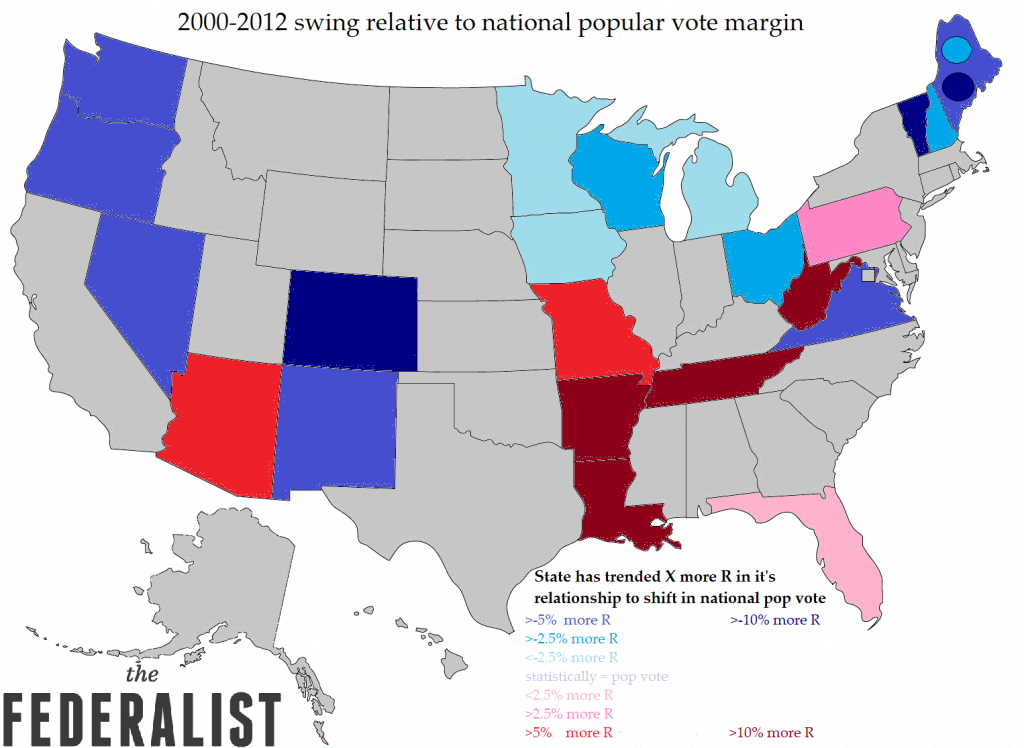
Why do I feel the sixth party system is cracking? Divisions within the Republican Party, an acceleration of corporate donors to the opposing party, and dramatic demographic changes are forcing the hand of the out-party while the in-party faces its own pushback over signature legislation. Younger voters may lean liberal but identify more independent, signaling that with the right conditions and messaging they aren’t a guarantee for Democrats going forward. Something will give within one or both parties, soon, to force another realignment. If Republicans think, they can guide it in their favor.
Setting forth a new, bold message that acknowledges the hardships people are going through, promises to fight those who enjoy keeping the status quo, and delivers a freer market with bolder opportunities and no more too-big-to-fail is the best way to build trust, excitement, and get those who may have ignored the Republican Party to give it a serious look. I can’t stress how many regular people out there legitimately feel left out of their government, ignored by their leaders, and angry that the people within the government-business collusion that created the bubble have only gained more power since. If a side effect is that the crooked, good-old-boy Republicans jump ship to the Democrats, and their business backers go with them, good riddance and all the better: you will have a clear delineation between the two parties, one many have wearily argued doesn’t exist.
Effects On GOP Prospects
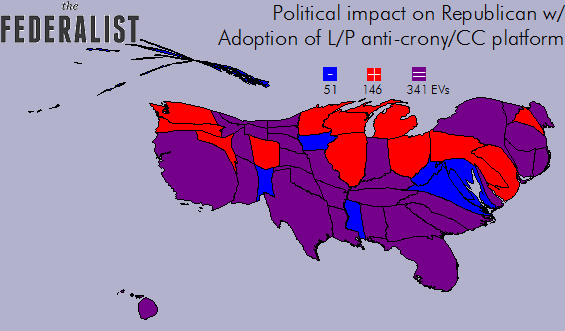
Right out of the gate, there is a downside to this strategy of fighting cronyism: certain states benefit strongly from the status quo, and their negative reaction to this shift would outweigh positives from various blocs. The first set of states is those most heavily invested in the current state of affairs: Maryland and Virginia. Both were insulated heavily from the effects of the recession, and would probably lose out if the corporatist system was unraveled. Washington DC would react negatively, as well, but its three electoral votes have never, ever mattered to the Republican Party.
The next batch of states is those whose residents have depended upon government largess and cronyism: West Virginia, Mississippi, and Alaska. While all are red states, and will likely stay that way, one could expect elections to be much closer if the GOP walks away from the crony table and Democrats happily fill their place. If care is not made to make farm bills clean, Iowa likely joins the “negative reaction group” too. Lastly, there is a state that enjoys a high rate of return in government spending ($3 for every $1 collected in tax) and has already trended away from the GOP demographically with little resistance: New Mexico. Their negative reactions will range, but on the whole these states will get a bit tougher for Republicans.
There is another class of states where it is unclear how much of a change would be evident within their voting population. California could break either way, with major companies and happy bureaucrats resisting as their inland populations turn their heads. New York’s business moderates may not react to the populist rhetoric while nominal gains are made in more traditionally Republican areas like upstate and Long Island. Texas is already a hotbed of conservatism and has become more Republican over the course of the sixth party system. But there are certainly areas of opportunity if you hone the message and study the demographics that could be most affected by this attitude change. To fully understand them, we need to look back at what went terribly wrong in 2012.
What Went Wrong in 2012
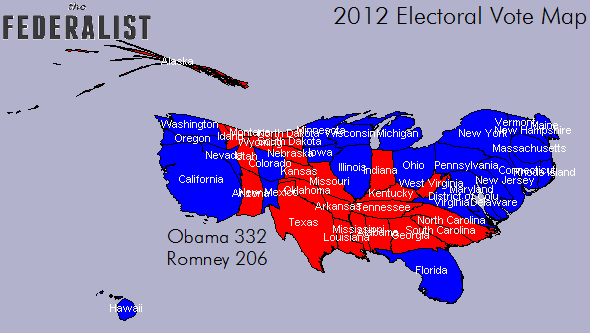
In Ronald Brownstein’s October 22, 2012 article, “Why Obama is Relying on the Rustbelt Instead of the Sunbelt,” a clear strategy had emerged from the president’s campaign staff that was devastatingly effective:
Veteran Democratic pollster Geoff Garin, who is advising an independent pro-Obama super PAC, says Romney has been left especially vulnerable by the region’s experience of industrial decline—of hearing managers say ‘these jobs are going boys and they ain’t coming back,’ to borrow from the lyrics of Bruce Springsteen, who campaigned for Obama last week in Iowa and Ohio.
‘The reaction to Romney as a rich guy out for rich guys is stronger and deeper in the Rustbelt,’ Garin says. ‘The Rustbelt narrative is about people who closed down factories and moved them some place else and it’s a story that people associate with Romney.’ Largely because that argument has proved so powerful, Obama is running much better with working-class whites in Ohio, Iowa, Wisconsin and Michigan than elsewhere in the country—and that difference represents his margin of advantage in these critical states.
Absent in that list is Pennsylvania but there, too, Obama’s PACs attacked Romney as a big-money jobs killer, targeting the very same working-class white voters. Obama’s strategists knew that most of these voters in these critical states, already skeptical of him in 2008, would not vote for him in 2012, and his margins were indeed slashed in Wisconsin, Pennsylvania, Ohio, Michigan, and Iowa. The way to win, then, was to ensure these voters would not turn out for Romney.
It makes you wonder just how much Romney’s “Wealthy McRichguy” caricature blocked his chances from the get go. Had a Republican candidate not had that background, or hadn’t been as slow to respond, Obama’s team would have found another line of attack, but it wouldn’t have been nearly as effective, and the 2012 general election could have ended quite differently: Wisconsin, Michigan, Pennsylvania, and Ohio combined would have robbed the president of re-election.
Don’t take me just at my word—look at the changes in total votes for the president between his two victories. In Michigan, President Obama lost 308,000 votes from 2008 to 2012, while Romney only gained a paltry 67,000 over McCain. Had just those “lost voters” switched to Romney, the race would have been decided by just four points. In Pennsylvania, the president shed 286,000 votes between 2008 and 2012, while Romney only gained 15,000. That flood of votes towards Romney would have made the race a one-pointer, without considering any Republican efforts to register new voters. In Ohio, the president shed almost 113,000 votes. That added to McCain’s 2008 grab and a bare majority of the libertarian vote would have meant a Romney win. The voters who “left” the president simply skipped the polling place in November 2012, and that apathy was directly the result of his team’s successful image-molding of his opponent.
The success of Obama for America’s strategy reflects a reality of the 2009-2012 years many on the Right ignored: while many voters were angry at President Obama over the health care law and sluggish economic growth, they were still very, very angry at the bailout-and-fire types they blamed for instigating the recession. All the president needed to shift the public’s attention was an opponent with which he could connect the dots, and Romney waltzed in from central casting.
Winning the Next Reagan Democrats
Winning these “Reagan Democrats” back with the anti-corporatist message won’t be enough to win these states beyond an election or two thanks to time—the youngest Reagan voter will be 50 years old in 2016—so the GOP must focus on the 43 percent or more of voters younger than 45 in the competitive states. An anti-corporatist message of demanding more responsibility, ending deals and bailouts, and actually standing for free markets won’t fall on deaf ears, though it may be greeted with initial skepticism. Generation X and Y voters are weary of lavish promises, and have seen a candidate come and promise change before only to become “another corporate shill,” to quote a Democratic Underground commentor. These voters aren’t impossible to get. With Romney’s failed campaign, here’s how the youngest blocs of voters broke in fifteen states (note: Romney(t)= statewide total, (g)= within this group, exit data not available 18-29 for Colorado or Oregon):
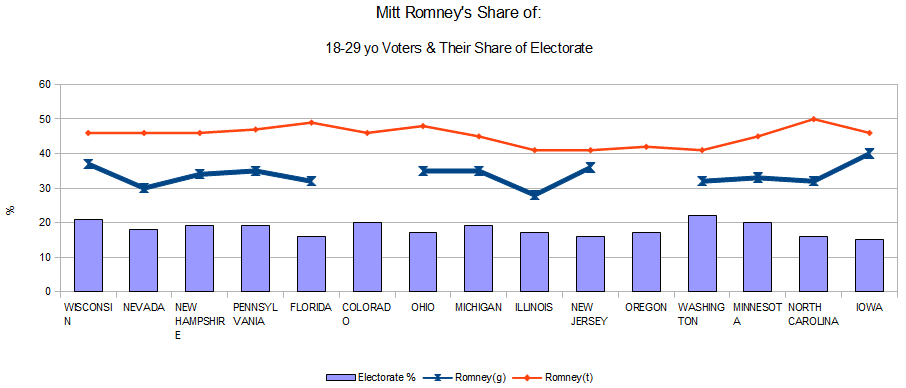
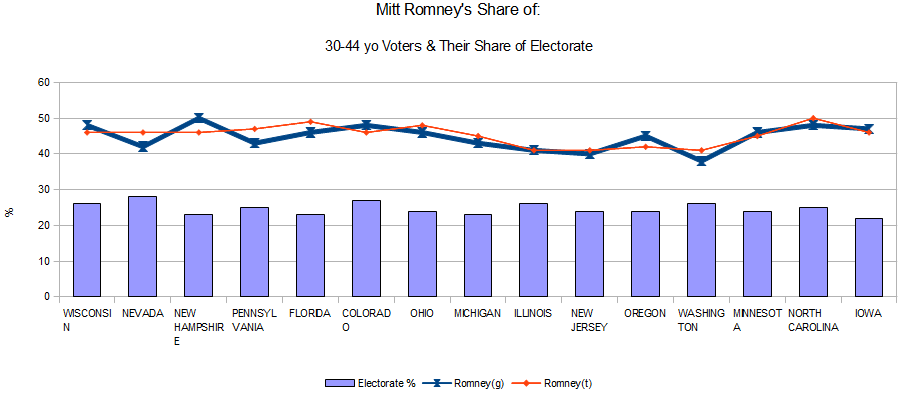
Poor in the former, slightly better in the latter, and hardly lockstep-Democrat territory. Imagine a candidate swapping out the “rich guy” look for the “fair shot” populism, and you can see where the numbers rise. There is something appealing about being told that your cynicism and skepticism of things is justified. An anti-corporatist message says to voters in my age bloc, and any for that matter: We see you are stressed, you are right about some of the characters causing it, and we are going to fight it. You are going to get a fair shot. We stand for the individual working to get ahead and succeed, regardless of their class. And, speaking of class…
The very message explained above will definitely appeal to those blocs most negatively affected by the economic downturn of 2007 and the sluggishness since: the lower and middle class. Here is how the voters making less than $50,000 and those making between $50,000 and $100,000 broke in the same states listed above.
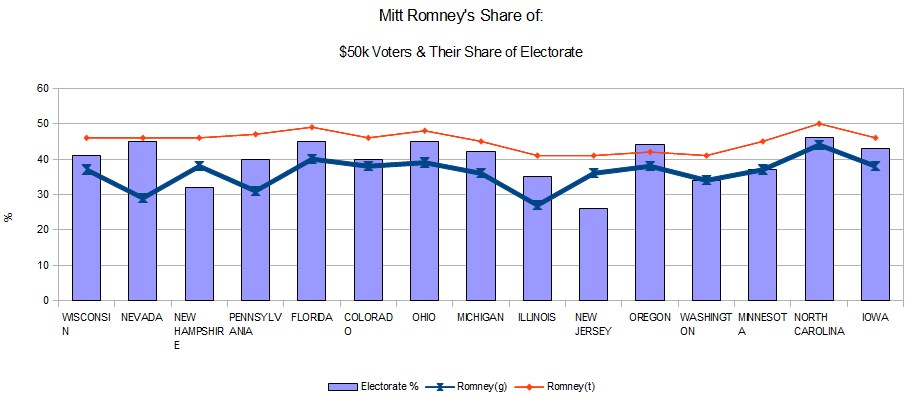
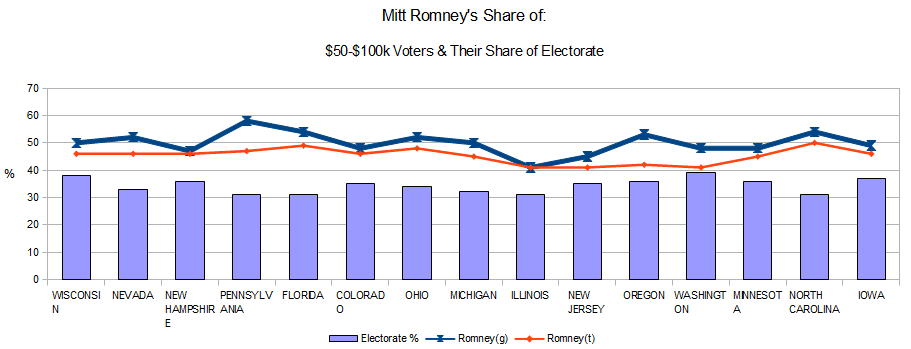
The middle class just barely broke for Romney. The lower class, suspicious of his business history thanks to effective targeting by Obama, rejected him. A nine-point bump in the lower class, and a six-point bump in the middle one, would have made the difference between losing and winning by more than a hundred electoral votes. Expanding “new GOP” margins with these groups by convincing them you understand the stresses, confirm their anger with the corporatists, and vow to clean up a market system muddied by a bureaucracy-boardroom alliance, will take time (just like with the younger voters) and action (blocking the Ex-Im Bank and explaining why is a great start).
But that growth will come as the fight is made real, cronies are chased out, and the new Republicans double down. Democratic activists have already stressed the importance of populism. If Republicans can get ahead of them while keeping the theme of truly “free markets” (a key element for conservatives and libertarians) in sight, they will hold most of the business conservatives, social conservatives, win outright the aforementioned Young Outsiders, Hard-Pressed Skeptics, and even a chunk of the New Left groups as designated by Pew. The electoral map that results with these groups swinging to this new GOP is decidedly more favorable to Republicans and reverses the long slide found in the sixth political party system.
With anti-corporatist, populist goals fully embraced, and the lower-class, middle-class, and younger voters targeted (in conjunction with the blue-collar voters Republicans botched a sweep with in 2012), we would expect Minnesota, Wisconsin, Michigan, Ohio, and Pennsylvania to become true toss-ups, not just pipe dreams of stoned, map-happy bloggers. The stressed-and-pressed, younger voters in Oregon and Nevada would also give Republicans solid chances in states that have become out-of-reach or teasingly so. Florida, with much older money, may bend away slightly, but the younger voters and conservative base will keep it a toss-up. As for outright gains, New Hampshire and Colorado, with their libertarian-independent spirit, would be the most receptive to this new fiscally-heavy, socially light, free-market GOP, showing favor to Republicans outright.
A few states will stay Democratic, but could be within reach in a good year. Illinois and New Jersey, states plagued with corruption and over-taxation, would be possible gets in a very good year as the fiscal message is emphasized. Washington state would be another candidate for some positive movement: it very narrowly voted to re-elect Sen. Patty Murray in a good GOP year, although outside of a spectacular year it would still favor the Democrats. If all of this looks awfully familiar, it should: this “new” map is far closer to the election of 2000, the first major one where Republicans had a chance to stall the rising fortunes of the Democrats.
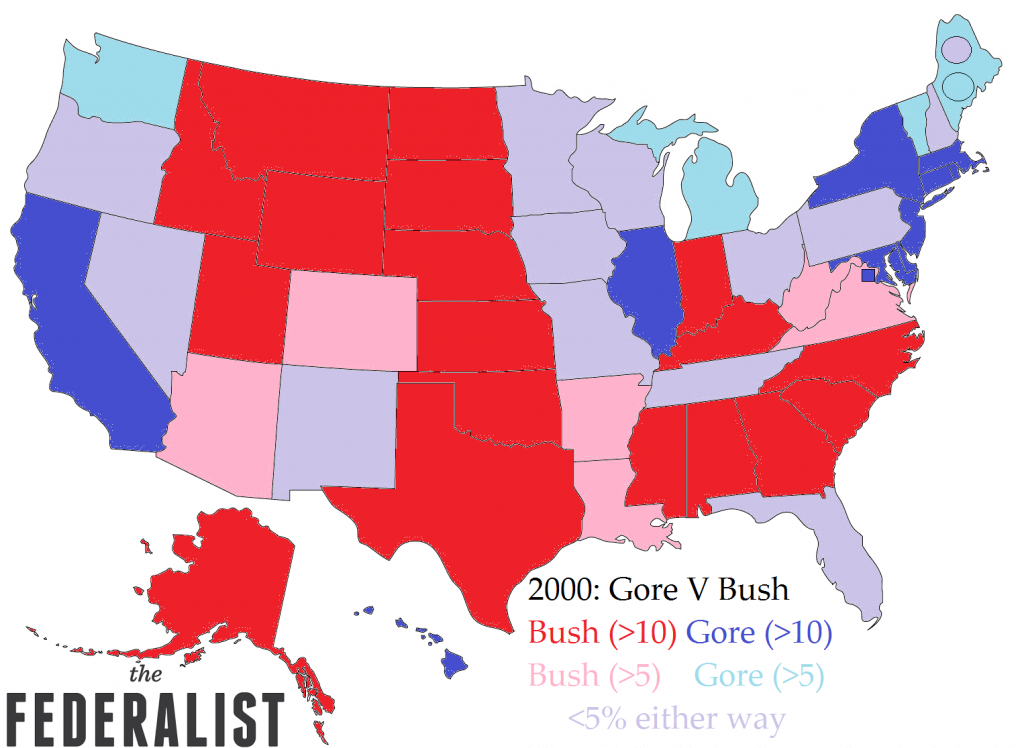
Nothing is guaranteed, of course. There will be good years and bad years. The states that may have shown more or less favor, but not enough to jump sides or become truly competitive, may do so in good and bad years:
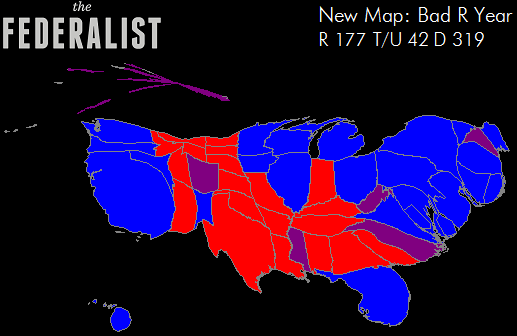
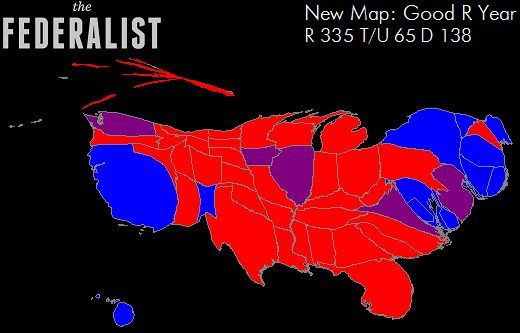
Candidate quality will matter. Modernizing get-out-the-vote efforts will matter too. Most of all, sticking to this shift will be difficult. Change isn’t easy, and party upheavals aren’t pretty. The careful dance with social conservatives—not barking at them to be quiet while encouraging them to hone their arguments and put their pulpit positions behind an emphasis on fiscal issues—has been made more complicated by a growing socon versus anti-socon division, and that is just one of the dozens of splinters that have plagued the Republican Party over the long slide in the sixth system. The party leadership has been at war with its base for much of that slide. I won’t even begin to pretend I have the magic beans required to end the fighting and pull all of this off, and I’d be weary of any one pundit or politician claiming to possess them.
But I urge the conservatives, libertarians, and reform types within the Republican Party to seriously consider this. Millions in the United States are tired of the games played by connected businesses and their political counterparts. No more bailouts, no more regulatory capture, no more holding the American taxpayers, workers and share-holders captive to the irresponsible whims of Congress, Inc. Will the Republican Party face a drain in its coffers? Perhaps. But there are far more voters in this country than there are people itching to fleece them. The sooner the party embraces a seismic change as proposed with this anti-corporatist populism, the sooner it will see a dramatic improvement in its electoral future. Even more important, the American people may actually get a government that represents them.
